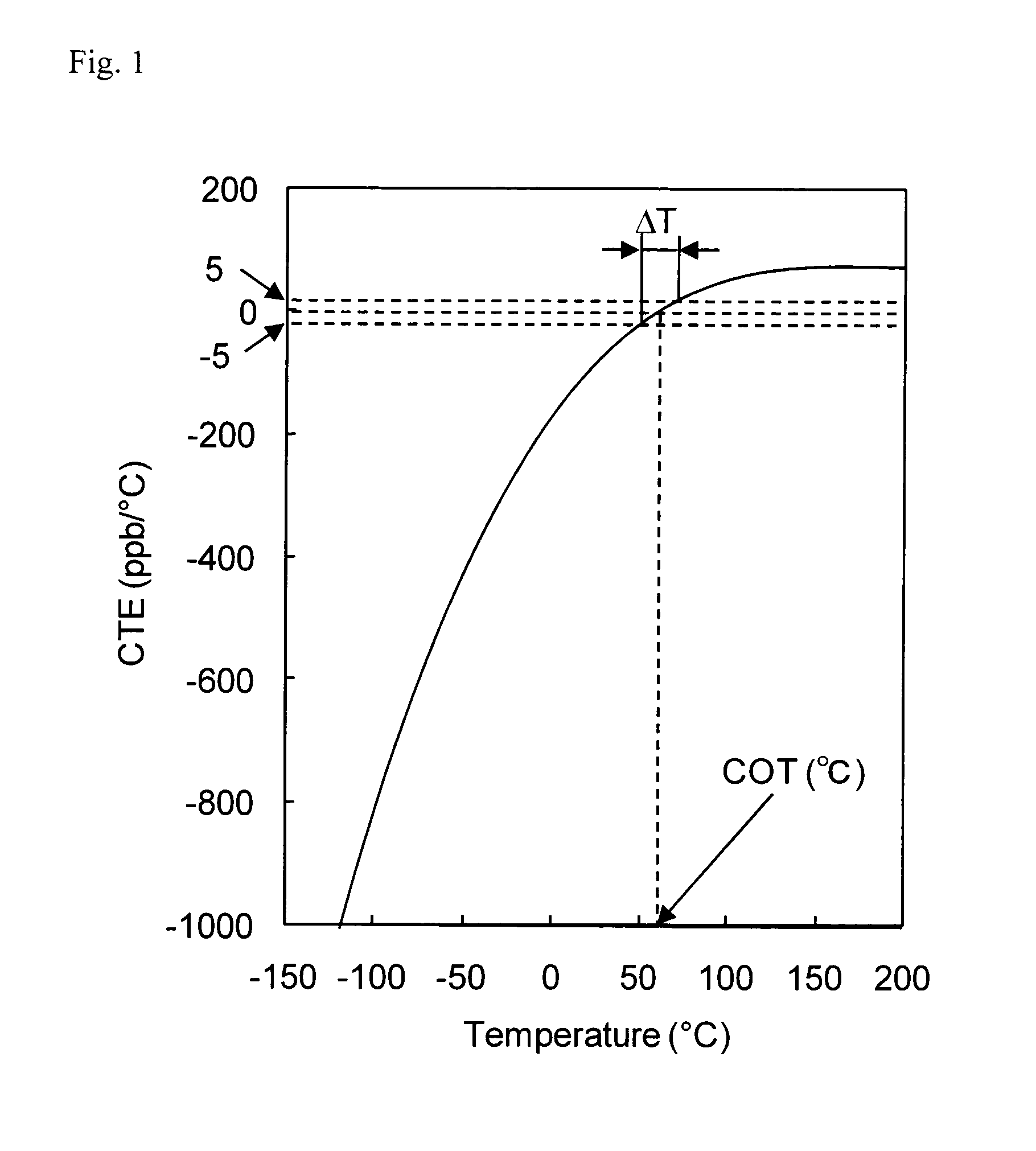Tio2-containing silica glass and optical member for lithography using the same
- Summary
- Abstract
- Description
- Claims
- Application Information
AI Technical Summary
Benefits of technology
Problems solved by technology
Method used
Image
Examples
example 1
[0067]TiO2—SiO2 glass fine particles obtained by gasifying each of TiCl4 and SiCla which are glass-forming materials for a TiO2—SiO2 glass, mixing these gases and subjecting the mixed gas to heat hydrolysis (flame hydrolysis) in oxyhydrogen flame is deposited and grown on a substrate to form a porous TiO2—SiO2 glass body (step (a)).
[0068]The obtained porous TiO2—SiO2 glass body is difficult to handle without any treatment and therefore, this porous glass body is kept in air at 1,200° C. for 6 hours together with the substrate and then separated from the substrate.
[0069]The porous TiO2—SiO2 glass body is set in an electric furnace capable of controlling the atmosphere. After reducing the pressure to 1,300 Pa at room temperature, water is charged into a glass-made bubbler, bubbling is performed with an He gas under a normal pressure at 80° C., and while introducing water vapor together with an He gas into the furnace, the glass body is kept in this atmosphere at 1,000° C. under normal...
example 2
[0074]A TiO2—SiO2 glass body is obtained in the same manner as in Example 1 except that in the step (a) of Example 1, the amount of TiCl4 supplied is slightly increased.
example 3
[0075]TiO2—SiO2 glass fine particles obtained by gasifying each of TiCl4 and SiCl4 which are glass-forming materials for a TiO2—SiO2 glass, mixing these gases and subjecting the mixed gas to heat hydrolysis (flame hydrolysis) in oxyhydrogen flame is deposited and grown on a substrate to form a porous TiO2—SiO2 glass body (step (a)).
[0076]The obtained porous TiO2—SiO2 glass body is difficult to handle without any treatment and therefore, this porous glass body is kept in air at 1,200° C. for 6 hours together with the substrate and then separated from the substrate.
[0077]The porous TiO2—SiO2 glass body is set in an electric furnace capable of controlling the atmosphere. After reducing the pressure to 1,300 Pa at room temperature, water is charged into a glass-made bubbler, bubbling is performed with an He gas under a normal pressure at 100° C., and while introducing water vapor together with an He gas into the furnace, the glass body is kept in this atmosphere at 1,000° C. under norma...
PUM
| Property | Measurement | Unit |
|---|---|---|
| Temperature | aaaaa | aaaaa |
| Temperature | aaaaa | aaaaa |
| Temperature | aaaaa | aaaaa |
Abstract
Description
Claims
Application Information
 Login to View More
Login to View More - R&D
- Intellectual Property
- Life Sciences
- Materials
- Tech Scout
- Unparalleled Data Quality
- Higher Quality Content
- 60% Fewer Hallucinations
Browse by: Latest US Patents, China's latest patents, Technical Efficacy Thesaurus, Application Domain, Technology Topic, Popular Technical Reports.
© 2025 PatSnap. All rights reserved.Legal|Privacy policy|Modern Slavery Act Transparency Statement|Sitemap|About US| Contact US: help@patsnap.com

